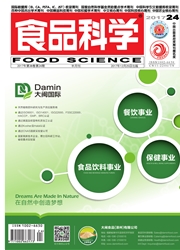

 中文摘要:
中文摘要:
目的:研究灵芝肽(GLP)对乙醇诱导的肝损伤小鼠的保护作用。方法:将60只小鼠随机分成6组,每组10只,分别为正常组,乙醇肝损伤模型组,硫普罗宁(Tiopronin)阳性对照组,GLP低、中和高剂量组。每天灌胃一次,GLP低、中、高剂量组分别灌胃GLP 60、120、180mg/kg bw,阳性对照组灌胃硫普罗宁溶液50mg/kg bw,正常组、模型组灌胃等量生理盐水;每次给药3h后,除正常组外,各组均灌胃50%乙醇16mL/kg bw,连续灌胃2周,建立小鼠酒精性肝损伤模型。通过脏器质量和体质量计算肝、脾脏指数;按照试剂盒的方法测定小鼠血清中谷丙转氨酶(ALT)、谷草转氨酶(AST)、甘油三酯(TG)含量,肝匀浆中超氧化物歧化酶(SOD)活力、丙二醛(MDA)含量、还原性谷胱甘肽(GSH)含量等指标。结果:60mg/kg bw GLP能极显著降低酒精性肝损伤所引起的ALT、AST活性和MDA、TG含量的升高(P〈0.01),有效地拮抗肝脏中SOD的活性与GSH含量的降低(P〈0.05~0.01)。结论:60mg/kg bw GLP对乙醇诱导的肝损伤小鼠有显著的保护作用,180mg/kg bw GLP的保肝效果好于50mg/kg bw硫普罗宁。
 英文摘要:
英文摘要:
The hepatoprotective effect of Ganoderma lucidum peptides(GLP) against alcohol-induced liver injury in mice was investigated.Totally 60 mice were randomly divided into 6 groups of 10 mice each: normal group,alcohol model group,tioronin positive control group and GLP treatment groups.The mice in GLP groups were daily administered GLP via gavage tubes at doses of 60,120 mg/kg bw and 180 mg/kg bw,respectively.Positive control group was administered tioronin at the dose of 50 mg/kg bw and other groups were administered saline at the identical volume.At 3 h postadministration,mice in all other groups except normal group were induced with 50% alcohol at 16 mL/ kg bw administration level to create a liver injury model,while mice in normal group were administered normal saline at the same volume.The indexes of liver and spleen were calculated.The alanine transaminase(ALT),aspartate transaminase(AST) and triglyceride(TG) level in serum,as well as malondialdehyde(MDA) and glutathione(GSH) levels,and superoxidedismutase(SOD) activity in liver were measured.GLP treatment at the dose of 60 mg/kg bw significantly reduced the elevation of AST,ALT,MDA and TG(P 〈0.01),and significantly inhibited the decrease of SOD activity and GSH levels(P〈0.05-0.01) in mice suffering from liver injury.In conclusion,GLP treatment at the dose of 60 mg/kg bw has a significant hepatoprotective effect against alcohol-induced liver injury in mice and a better hepatoprotective effect of GLP treatment at the dose of 180 mg/kg bw was achieved compared to tioronin treatment at the dose of 50 mg/kg bw.
 同期刊论文项目
同期刊论文项目
 同项目期刊论文
同项目期刊论文
 期刊信息
期刊信息
